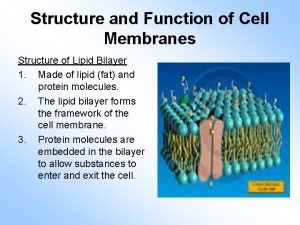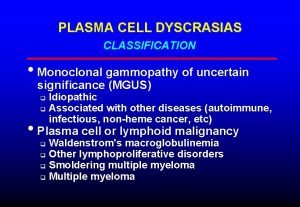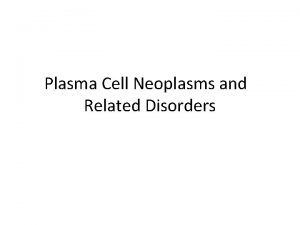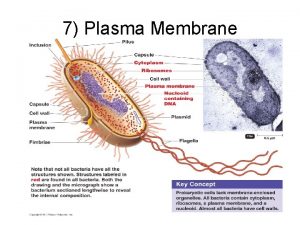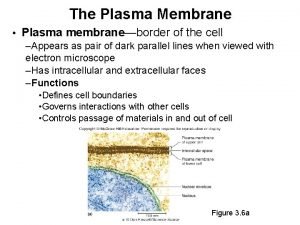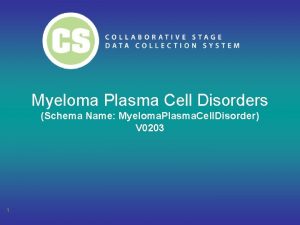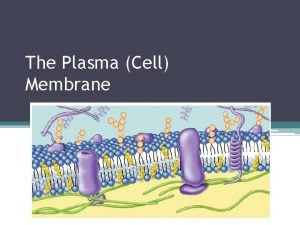Plasma cell neoplasms Plasma cell neoplasms Plasma cell




















- Slides: 20

Plasma cell neoplasms

Plasma cell neoplasms • Plasma cell neoplasms are a group of B cell neoplasms associated with the monoclonal proliferation (single clone) of immunoglobulinsecreting plasma cells. • These are also known as dyscrasias.

Laboratory Findings • Peripheral Blood • Hemoglobin: Decreased and usually between 6 and 10 gm/d. L. • Peripheral smear • RBCs: • WBCs: • Platelets

Laboratory Findings • Peripheral Blood • Peripheral smear • RBCs: • Usually normocytic normochromic anemia • Tendency for the red cells to adhere to one another and form columns in the blood film referred to as rouleaux formation. • This is due to increased immunoglobulins. • Rouleaux formation is characteristic but not diagnostic, as it may be seen in any condition with elevated immunoglobulins.

Laboratory Findings Peripheral Blood Peripheral smear RBCs: WBCs: Total and differential leukocyte count is normal. In terminal stages of the disease, few plasma cells may be observed in the peripheral blood. • If number of plasma cells is higher than 2 × 109/L, it is labeled as plasma cell leukemia. • Platelets: Platelet count is usually within normal limits. • • •

Laboratory Findings • ESR: Increased because of rouleaux formation due to high immunoglobulin levels. • Bleeding time: Platelets may get coated by M-component which impairs platelet aggregation resulting in increased bleeding time

Laboratory Findings • Bone Marrow • Cellularity: • Bone marrow is hypercellular, as a result of increased number of plasma cells and myeloma plasma cells (neoplastic plasma cells).

Laboratory Findings

Laboratory Findings • Increased number of myeloma plasma cells more than 30% of the cellularity is diagnostic • When their number is less than 10%, demonstration of their monoclonal (κ or λ) nature is highly suggestive of myeloma. • Myeloma plasma cells are neoplastic plasma cells that vary from mature plasma cells, plasmablasts (immature) and pleomorphic plasma cells.

Laboratory Findings • Myeloma plasma cells (mature type) are large usually oval with round to oval eccentrically placed nucleus and abundant pale blue cytoplasm. • Nucleus may show “spoke wheel” or “clock-face” chromatin without nucleoli. • A perinuclear hof (clearing) due to a prominent Golgi apparatus is present. • Few of these cells may show binucleation and multinucleation.

Laboratory Findings • Plasmablastic (immature) myeloma cells have higher nuclear/cytoplasmic ratio and round nucleus with vesicular/dispersed chromatin often with prominent single nucleolus. • Presence of these cells is associated with a worse prognosis. • Pleomorphic plasma cells are multinucleated or polylobated.

Laboratory Findings Other morphological findings • Flame cells: These cells show peripheral fiery red (vermilion staining) glycogen-rich immunoglobulin A and have irregularly shaped or flame -like cytoplasm and hence the name. • Grape (morula/mott) cells: These cells have multiple bluish-white, grapelike rounded cytoplasmic droplets. • Russell bodies: These are globular, eosinophilic (cherry red), refractile inclusions in the cytoplasm. • Cells with a variety of other inclusions: These include fibrils (Gaucher -like cells, thesaurocytes), crystalline rods and globules. • Dutcher bodies: They represent intranuclear pseudo inclusions.

Laboratory Findings

Laboratory Findings • Erythropoiesis: It is diminished and is normoblastic. • Myelopoiesis: It shows normal maturation. • Megakaryopoiesis: Normal. • As the tumor progresses, it may compromise erythroid, myeloid and megakaryocytic progenitors resulting in pancytopenia

Laboratory Findings • Urine: It may show Bence Jones protein

Laboratory Findings • Serum β 2 microglobulin: It is a useful prognostic marker and high values signify poor prognosis. • Hypercalcemia: It is due to extensive osteolytic lesions and osteoporosis and there also increased levels of serum phosphate and serum alkaline phosphatase. • Blood urea, serum creatinine and uric acid: They are often raised when there is impairment of renal function. This is associated with reduced creatinine clearance. • Serum albumin: Decreases in advance stages of the disease.

Electrophoretic Studies on Serum and Urine • Electrophoretic studies reveal raised levels of immunoglobulins in the blood and/or light chains (Bence Jones proteins) in the urine. • The monoclonal immunoglobulin (“M protein”) is identified as abnormal protein “spikes” in serum or urine electrophoresis and is then further characterized by immunofixation. • The most common M protein is Ig. G type, followed by Ig. A.

Serum electrophoresis showing normal pattern: (A) and monoclonal immunoglobulin (“M Band”) in multiple myeloma (B)


 Dr kiran bidari
Dr kiran bidari Plasma cell mastitis treatment
Plasma cell mastitis treatment Cell membrane function
Cell membrane function Plasma cell neoplasm
Plasma cell neoplasm Waldenstrom's disease
Waldenstrom's disease Plasma cell dyscrasias classification
Plasma cell dyscrasias classification What is the gooey liquid in plant and animal cells
What is the gooey liquid in plant and animal cells Venn diagram of plant and animal cell
Venn diagram of plant and animal cell Walker cell and hadley cell
Walker cell and hadley cell The scientist mathias schleiden studied _______ in ______.
The scientist mathias schleiden studied _______ in ______. Differences between plant animal and bacterial cells
Differences between plant animal and bacterial cells Vacuole function
Vacuole function Function of cells
Function of cells Cell cycle and cell division
Cell cycle and cell division Events of the cell cycle
Events of the cell cycle Advantages of diaphragm cell
Advantages of diaphragm cell Finite and continuous cell lines
Finite and continuous cell lines Concentration of cells
Concentration of cells Prokaryotic cell vs eukaryotic
Prokaryotic cell vs eukaryotic Cell-cell junction
Cell-cell junction Plant cell vs animal cell
Plant cell vs animal cell


